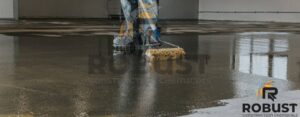Polyurethane coating is a versatile and highly effective solution for protecting and enhancing various surfaces. Its unique properties make it a popular choice across industries such as construction, automotive, and furniture. This article delves into the details of polyurethane coating, exploring its applications, benefits, types, and tips for application, while maintaining a conversational and accessible tone.
Polyurethane coating is a highly effective solution for protecting concrete surfaces due to its durability, flexibility, and resistance to chemicals and environmental factors. Here’s an overview:
Features of Polyurethane Coating for Concrete
1. High Durability: Offers excellent resistance to wear, abrasion, and impact.
2. Waterproofing: Provides a seamless, impermeable layer that prevents water penetration.
3. Chemical Resistance: Protects against oils, acids, alkalis, and other harsh substances.
4. UV Resistance: Ideal for outdoor applications, as it resists yellowing and degradation under sunlight.
5. Flexibility: Can accommodate minor concrete movements without cracking.
6. Smooth Finish: Creates an aesthetically pleasing, glossy or matte surface.
Applications
Parking lots
Industrial floors
Roofs
Basements
Bridges
Decorative concrete
Application Process
1. Surface Preparation: Ensure the concrete is clean, dry, and free of debris or oil.
2. Primer Application: Apply a compatible primer for better adhesion.
3. Coating Application: Use a brush, roller, or spray gun to apply the polyurethane in multiple layers.
4. Curing: Allow proper curing time between coats and after the final application.


What is Polyurethane Coating?
Polyurethane coating is a polymer-based material that forms a durable and protective layer when applied to surfaces. It is prized for its excellent resistance to abrasion, chemicals, and weathering, making it ideal for both indoor and outdoor use. This coating can be either water-based or solvent-based, catering to different application needs and environmental considerations.
Types of Polyurethane Coating
Polyurethane coatings are categorized based on their formulation and application method. Here are the primary types:
1. Acrylic Polyurethane Coating
Acrylic polyurethane coatings are known for their superior UV resistance. They are commonly used on surfaces exposed to sunlight, such as exterior walls, vehicles, and outdoor furniture. These coatings also provide a smooth and glossy finish.
2. Aliphatic Polyurethane Coating
Aliphatic polyurethanes are highly durable and resistant to fading, chalking, and yellowing. They are often used in high-performance applications, such as industrial equipment and aircraft, where appearance and longevity are crucial.
3. Aromatic Polyurethane Coating
Aromatic polyurethanes are less resistant to UV light but excel in chemical and abrasion resistance. They are typically used for interior applications or areas where UV exposure is minimal.
4. Water-Based Polyurethane Coating
Water-based polyurethanes are environmentally friendly and emit fewer volatile organic compounds (VOCs). They are ideal for residential applications and spaces where air quality is a concern.
5. Solvent-Based Polyurethane Coating
Solvent-based polyurethanes offer higher durability and resistance compared to their water-based counterparts. They are commonly used in industrial and commercial settings where heavy-duty protection is required.
Applications of Polyurethane Coating
Polyurethane coating finds extensive use in a variety of industries due to its adaptability and effectiveness. Some of its key applications include:
1. Flooring
Polyurethane coatings are widely used on concrete floors in industrial, commercial, and residential spaces. They provide a smooth, glossy finish that is resistant to scratches, stains, and heavy foot traffic.
2. Automotive
In the automotive industry, polyurethane coatings protect vehicle exteriors from UV rays, corrosion, and abrasions. They also enhance the aesthetic appeal with a shiny and polished look.
3. Wood Furniture
Polyurethane coatings safeguard wood furniture from moisture, scratches, and wear and tear, while also enhancing the wood’s natural beauty.
4. Metal Structures
Metal structures like bridges, pipelines, and industrial machinery benefit from polyurethane coatings due to their resistance to rust, corrosion, and harsh environmental conditions.
5. Marine Applications
In marine environments, polyurethane coatings protect boats and other equipment from saltwater corrosion and damage caused by constant exposure to moisture.
Benefits of Polyurethane Coating
The widespread use of polyurethane coating can be attributed to its numerous benefits, which include:
1. Durability
Polyurethane coatings are known for their exceptional toughness and long-lasting performance. They can withstand heavy use and harsh conditions without degrading.
2. Versatility
These coatings can be applied to a wide range of materials, including wood, metal, concrete, and plastic. This versatility makes them suitable for diverse applications.
3. Chemical Resistance
Polyurethane coatings resist chemicals such as oils, solvents, and acids, making them ideal for industrial environments where chemical exposure is common.
4. Weather Resistance
Their ability to withstand UV rays, rain, and temperature fluctuations makes polyurethane coatings perfect for outdoor use.
5. Aesthetic Appeal
Polyurethane coatings provide a smooth and glossy finish, enhancing the appearance of surfaces while protecting them.
6. Ease of Maintenance
Surfaces coated with polyurethane are easy to clean and maintain, requiring minimal effort to keep them looking their best.
How to Apply Polyurethane Coating
Proper application is essential to ensure the effectiveness and longevity of polyurethane coating. Here’s a step-by-step guide:
1. Surface Preparation
Ensure the surface is clean, dry, and free of dust, grease, or old coatings. For porous surfaces like wood or concrete, sanding may be necessary to achieve a smooth finish.
2. Choose the Right Type
Select the appropriate type of polyurethane coating based on the surface material and application requirements. For instance, use water-based polyurethane for residential projects and solvent-based for industrial use.
3. Apply the Coating
Use a brush, roller, or spray gun to apply the polyurethane coating evenly. Follow the manufacturer’s instructions regarding the thickness and number of coats.
4. Allow Proper Drying Time
Polyurethane coatings require adequate time to dry and cure. Avoid using the surface until the coating has fully cured, as this ensures maximum durability and performance.
5. Safety Precautions
Wear protective gear, such as gloves and masks, to avoid skin contact and inhalation of fumes, especially when using solvent-based polyurethanes.
Maintenance Tips
To keep surfaces coated with polyurethane in optimal condition, follow these maintenance tips:
Clean the surface regularly using a mild detergent and a soft cloth or mop.
Avoid using abrasive cleaners or scrubbing pads, as they can damage the coating.
Reapply a fresh layer of polyurethane coating as needed to maintain protection and appearance.
Environmental Considerations
While polyurethane coatings offer numerous advantages, it’s important to consider their environmental impact. Water-based polyurethanes are a greener option as they emit fewer VOCs and are less harmful to the environment. Always dispose of leftover coatings and materials responsibly to minimize ecological damage.